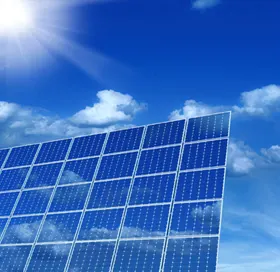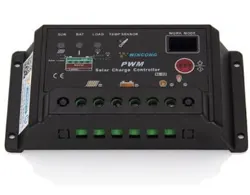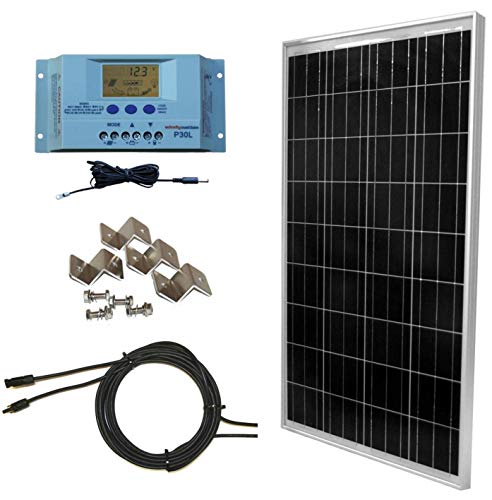
How to Size a Solar Power System
How to Size a Solar Power System Correctly
![]() Solar Panels are becoming more common place and investing in a solar photovoltaic system is a smart solar solution for most homeowners. This now proven and reliable technology offers long-term performance with low maintenance. The latest solar panels and PV systems are cheaper, easier to install, maintain and operate more efficiently than ever before so its important to know how to size a solar power system in order to get the best from it.
Solar Panels are becoming more common place and investing in a solar photovoltaic system is a smart solar solution for most homeowners. This now proven and reliable technology offers long-term performance with low maintenance. The latest solar panels and PV systems are cheaper, easier to install, maintain and operate more efficiently than ever before so its important to know how to size a solar power system in order to get the best from it.
The primary goal of any photovoltaic solar system is to offset all or some of your electricity needs with free power from the sun. The percentage of your energy needs that you will be able to supply with a solar system will depend on many factors, including your homes (or other location) power consumption, the efficiency of the system you install, and where your home is located. Ideally for solar panels this would be somewhere that experiences cold temperatures to keep the panels cool but that also receives plenty of sunlight to generate lots of free power.

Sizing a solar system can be tricky, especially if you are installing a system in a new home, RV, mountain cabin or do not know your homes energy needs. In such cases, how do you know how many solar panels or how much solar energy you require.
You could “guesstimate” your annual energy usage if you know your energy consumption patterns or have details of your energy bills. Having a reasonably accurate estimation of your energy consumption will help you design the correct size of the solar system you need.
For this simple example, let’s assume we want to design a solar photovoltaic system for a stand-alone off-grid garden summer house (or shed) with battery back-up for the use of lighting at night. How would we size a solar power system for such an application.
How To Size A Solar Power System
1. Energy Consumption
What most people do first is to make a list of the power consumption of all the electrical appliances and devices that will be used in their particular home or location and an estimate of how long each appliance or device is switched-ON using energy each day.
Once this is complete multiply the power consumption (in watts) of each device by the number of hours it is on to give you the daily electrical consumption in watt-hours, as shown.
| Appliance | Watts | Hours/Day | Watt-hours per Day |
|---|---|---|---|
| Two 60W Incandescent Lights | 120W | 4 | 480 Whrs |
| Fluorescent Outside Light | 20W | 6 | 120 Whrs |
| Ceiling Fan | 50W | 4 | 200 Whrs |
| Colour LCD TV | 70W | 4 | 280 Whrs |
| Portable Laptop | 50W | 6 | 300 Whrs |
| Wi-Fi Router | 10W | 6 | 60 Whrs |
| Total: 1440 Whrs | |||
Then the total energy consumption is estimated at around 1440 Watt-hours, or 1.44 kilowatt-hours per day. However, it is better to add a little extra on top, say 10% to 25%, to account for losses in the system, or the use of an extra electronic device not accounted for. Thus the new estimated value would be: 1440 watt-hours x 1.25 (25% extra) = 1800 watt-hours or 1.8 kWh.
2. Sun Hours Per Day
As solar power generation is based on incident sunlight on the PV panels rather than heat, it is necessary to know how many hours of direct sunlight the panel or panels will be exposed too throughout the day. The amount of energy you can get from solar electricity at an off-grid site depends on its location and the time of the year. Generally in the northern hemisphere you can expect to receive more sunlight between the months of April through to September and have a clear exposure to the sun for most of the day, e.g. 9am to 3pm.
A solar PV panel produces the most power when it is pointing directly to incident sunlight, so that the sun’s rays shine straight down onto its surface. Solar panel orientation is important as any solar panels should be located and angled to where they will receive as much sunlight as possible, averaged out during the course of the day, a month or a full year. Fortunately, most homes and gardens have good solar access with roofs that are often free from obstructions that can shade the solar panels.
The measurement for the strength of the sunlight striking the Earth at your location is defined as solar insolation and you’ll need to know the peak sun-hour figure for your location. Having a good solar site is important to ensure that the PV panels are exposed to bright sunlight every day of the year. It also ensures you are collecting the solar power more effectively as well. Generally during the winter season this can be as low as 4 hours or as high as 8 hours during the summer season.
Fortunately there are plenty of good websites available such as NASA’s Solar Insolation Website. Using this solar insolation database can help size the minimum solar electric (PV) system needed during the periods of the year with the shortest amount of sunshine for your particular site or location.
Lets assume then that for our particular location the lowest solar insolation occurs during the month of January with only 4.8 hours of sunshine per day. Therefore, the total peak power generated by the sunlight in the month of January will be: 1800 watt-hours/4.8 hours = 375 watts-peak, or 375Wp. This could be rounded off if required to 400Wp to keep the maths simple.
3. Determine Number of Solar Panels
We already have an accurate idea of the solar insolation for a particular site. We’ve done the electrical loads list survey so we know how much electric power we require on an average day. All that remains is to specify the type and number of photovoltaic (PV) panels that will produce the required power of 1.8 kilowatts.
There are literally hundreds of different solar panels to choose from and all vary in type, size, shape, and voltage rating. In most cases the size of a photovoltaic panel refers to the panel’s rated output wattage or electricity generating potential.
Solar panels can also have different voltage ratings depending upon their construction and size. Those that produce 12 to 48 volts output are generally used for off-grid applications. Maximum power ( Pmax ) delivered by a single panel at full sun is given as Maximum Power Voltage ( Vmp ) time Maximum Power Current ( Imp ).
For our particular off-grid example we required battery storage and back-up so the system will be powered using 12 Vdc photovoltaic solar modules for convenience.
So again, let us assume that we have done our research on panel availability, price, and size, and we have decided to use 12 volt 100 Wp Solar Panels with the following electrical specifications: Pm = 100Wp, Vmp = 17.5 Vdc, Imp = 5.7A, Voc = 21.0V, Isc = 6.2A.
Thus the total number of PV panels required will be: 375Wp/100 Wp = 3.75 = 4 solar panels rounded off to the nearest whole panel.
So our garden summer house example will be powered by at least four 100 Watt solar photovoltaic panels with the four panels connected together in parallel to give the required system voltage of 12 Volts.
4. Storage Battery Sizing
Unfortunately the sun does not always shine, especially at night, so some additional backup is required. During a nice sunny day, the solar panels can produce a lot of electrical power so to allow us to use the summer house during the night, winter time or during periods of low solar insolation, we will need batteries to access that power after the sun goes down.
The amount of energy that will be consumed per day in the summer house was calculated at 1800 watt-hours previously using the information above. This is the minimum amount of storage capacity we need for one day. Next we need to determine the number of days of battery back-up that we want to have on hand. This is called “Autonomy”.
Days of Autonomy represents the number of cloudy days in a row that might occur and for which the batteries will need to supply energy to the building. A standard number of autonomy days are usually 3 days. Then the total amount of energy required for a minimum of three (3) days of storage for our garden summer house that consumes 1800 watt-hours daily is calculated as:
Appliances use 1800 Watt-hours/day, nominal battery voltage = 12 volts, days of autonomy will be 3 days and efficiency = 85%.
Battery capacity = (1800 x 3)/(0.85 x 12) The total ampere-hours required is therefore 529Ah or greater of battery capacity at 12 volts.
5. Determine Solar Charge Controller

All solar power systems with batteries as backup should include a Solar Charge Controller to prevent the batteries from overcharging and also to prevent the batteries from sending their charge back through the system to the solar panels during times of low sun, (i.e., night time).
Since a solar controller does its work in line between the solar panel array and the storage batteries, it makes sense that its selection and sizing is influenced by those components.
Voltage and current are the two parameters used in solar charge controller sizing. The solar controller must be capable of accepting the maximum power produced by the solar panels while delivering the proper DC voltage and charging current to the batteries.
For systems in continuous operation the industry standard 1.2 (20% extra) de-rating factor is specified to prevent the controller from becoming damaged due to excess solar panel current or power. The solar panels above have a short circuit current (Isc) of 6.20A. The solar charge controller rating will therefore be: 4 solar panels with rated current of 6.20A each = 4 x 6.20 x 1.2 = 29.76 A or 30Amps. So the solar charge controller like the one on the left should be rated 30 Amps at 12 V or greater.
6. Off-grid DC to AC Inverter
We have calculated that for our simple example, we would require four 100Wp solar panels, and a 30 Amp solar charge controller to charge the 12 volt batteries. Unfortunately, this set-up will not power large TV’s, home computers, fridge/freezer, etc, as these devices require 240 VAC to operate. Then we need to transform the 12 DC voltage into 240 volts AC (alternating current) and to do this we would need a sinewave inverter.
The total wattage of all electrical appliances that we listed above for use in our garden summer house was: 120 + 20 + 50 + 70 + 50 + 10 = 320 Watts. For safety, the inverter should be considered 20-25% bigger size. The inverter size should therefore be about 400 Watts or greater.
Then for our simple example above of an off-grid back yard type summer house, we would need four 100Wp solar panels, a 30A charge controller feeding a single or set of batteries rated at 529Ah, plus additional 16mm2 (10AWG) cabling and 30A isolator switches. If we also wanted to power our electrical appliances using 240VAC, a DC to AC inverter of about 400 watts would also be required.
How to Size a Solar Power System Summary
Hopefully by now you will have some idea of how to size a solar power system for your home or garden, whether off-grid with battery backup or a grid connected pv system. These steps in determining the size of solar system are by no means the only ones, each case is different and there are different ways in sizing solar PV systems.
But the first step in going solar is not the size of the solar system, but reducing electricity usage through conservation and efficiency measures. Energy conservation and good home design plays an important role in keeping down the size and cost of a photovoltaic (PV) system. The use of energy efficient appliances and lighting, as well as non-electric alternatives wherever possible, can make an off-grid solar photovoltaic or even wind powered system a cost competitive alternative to the utility power grid.
The amount of sun-hours per day, days of autonomy and your homes average energy consumption will determine the size and ultimately the cost of any photovoltaic solar electricity system. Negative-watt-hours are the watt-hours you can save by conserving energy and not using it in the first place.
The cost of reducing your energy consumption with negative-watt-hours is about 20 to 30% cheaper than producing those same watt hours using an oversized PV system. Plus, the resulting smaller system means fewer solar panels, less space and less cost.
To learn more about solar energy, photovoltaic panels, or to learn how to build your own solar energy system using 100W panels to save money, Click Here to find more solar panels and start generating your own solar energy today.











Your point is valid but he is considering a scenario of instantaneous power equal or less than 400 watt.
On calculation number 3 where is the 375 coming from?
1800 watt-hours/4.8 hours = 375 watts-peak, or 375Wp. Please read section 2. Sun Hours per Day
A beginner and hoping to be a professional
thanks for the information, this is one of the best sources I have found and indeed helped me a lot
it has been a long way problem for me to size the pv system but after going through your processes am now a pro….thank you so much
I sincerely thank you for this article, it is well elaborated. It is good for DIY members like me.
Thanks for the article .
Between solar panel and battery capacity which should be calculated first
Battery storage capacity is linked to hours or days of autonomy required. Then once your storage capacity is known, you can size your panels and array accordingly to fully charge the battery bank during the solar hours available
good article,an important future of energy requirement & its developments.
Very informative article!!!
PS- it should be watt hrs instead of watt/hr in the table for energy consumption.
Thanks 🙂
Interesting article as explained in a very professional way for those who want to makes their homes to be equipped with renewable energy solutions
Good day! this a good article, please can i have a complete step by step manual on sizing solar off grid system, i am into solar installation and i need more information to be better equip
The tutorials are offered free of charge to everyone who wants to learn about the various Renewable Energy technologies. There are no step by step guides.
Please up date me
Eye opener and great.
i am a beginner solar energy and i hope to be a professional
As a student undertaking research in this field, it is a good article.
working out the size of the panels and how many is the hardest thing. I installed a solar system in my back yard to power lights but needed to add two extra panels to keep them lit all night. this is an interesting article.
Thanks for the information. 🙂
What if you only had 1 load rated at 1.44kW and it ran for exactly 1 hour during the day. Our calculation would still evaluate to us requiring a 345W panel. This does not sound right as a 345W cannot power a 1.44kW load? Where am I going wrong
Your point is Valid, a 345 panel and 400 Watts inverter will not power it actually from your own argument. so there are other things to consider. In his calculation he is making some assumptions that load does not exceed 320 to 400 watts instantaneously.
The design is based on instantaneous power of equal or less than 400 watt.